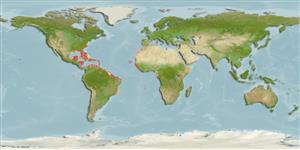Common names from other countries
>
Acanthuriformes (Surgeonfishes) >
Acanthuridae (Surgeonfishes, tangs, unicornfishes) > Acanthurinae
Etymology: Acanthurus: Greek, akantha = thorn + Greek, oura = tail (Ref. 45335).
More on author: Bloch.
Environment: milieu / climate zone / depth range / distribution range
Écologie
marin récifal; profondeur 2 - 25 m (Ref. 7345), usually 2 - 15 m (Ref. 27115). Subtropical; 22°C - 25°C (Ref. 27115); 43°N - 30°S, 98°W - 14°W (Ref. 55164)
Western Atlantic: Massachusetts (USA), Bermuda, and the northern Gulf of Mexico to São Paulo, Brazil. Eastern Atlantic: Senegal.
Length at first maturity / Taille / Poids / Âge
Maturity: Lm ?, range 17 - ? cm
Max length : 39.0 cm TL mâle / non sexé; (Ref. 47377); common length : 35.0 cm TL mâle / non sexé; (Ref. 5217); poids max. publié: 5.1 kg (Ref. 40637)
Épines dorsales (Total) : 9; Rayons mous dorsaux (Total) : 24 - 25; Épines anales: 3; Rayons mous anaux: 22 - 23. Caudal fin slightly emarginate (Ref. 13442). Body gray, with 10 well-spaced, narrow, darker gray vertical bars on side (Ref. 26938).
Inhabits shallow reefs or rocky areas. Found in loose aggregations (Ref. 9710). Mainly diurnal. Ingests sand when feeding on algae (Ref. 13442). The spine on both sides of the caudal peduncle may inflict painful wounds (Ref. 5217). Minimum depth reported from Ref. 27115. Larvae are planktonic (Ref. 47377). At Fernando de Noronha Archipelago in southwestern Atlantic, juveniles hold cleaning stations together with the blue tang (Acanthurus coeruleus) and sergeant major (Abudefduf saxatilis) and graze algae as well as pick molted skin and parasites from green turtles (Chelonia mydas). This behavior is preceded by a characteristic inspection usually followed by feeding nips on the turtles’ skin (head, limbs, and tail), as well as on the carapace. The most inspected and cleaned body parts are the flippers (Ref. 51385).
Life cycle and mating behavior
Maturities | Reproduction | Spawnings | Egg(s) | Fecundities | Larves
Robins, C.R. and G.C. Ray, 1986. A field guide to Atlantic coast fishes of North America. Houghton Mifflin Company, Boston, U.S.A. 354 p. (Ref. 7251)
Statut dans la liste rouge de l'IUCN (Ref. 130435)
CITES (Ref. 128078)
Not Evaluated
Menace pour l'homme
Traumatogenic (Ref. 5217)
Utilisations par l'homme
Pêcheries: intérêt commercial mineur; Aquarium: Commercial
Outils
Articles particuliers
Télécharger en XML
Sources Internet
Estimates based on models
Preferred temperature (Ref.
115969): 26.1 - 28, mean 27.4 (based on 769 cells).
Phylogenetic diversity index (Ref.
82804): PD
50 = 0.5000 [Uniqueness, from 0.5 = low to 2.0 = high].
Bayesian length-weight: a=0.02188 (0.01789 - 0.02676), b=2.95 (2.91 - 2.99), in cm Total Length, based on LWR estimates for this species (Ref.
93245).
Niveau trophique (Ref.
69278): 2.1 ±0.1 se; based on diet studies.
Résilience (Ref.
120179): Milieu, temps minimum de doublement de population : 1,4 à 4,4 années (K=0.25-0.50).
Fishing Vulnerability (Ref.
59153): Low vulnerability (23 of 100).
